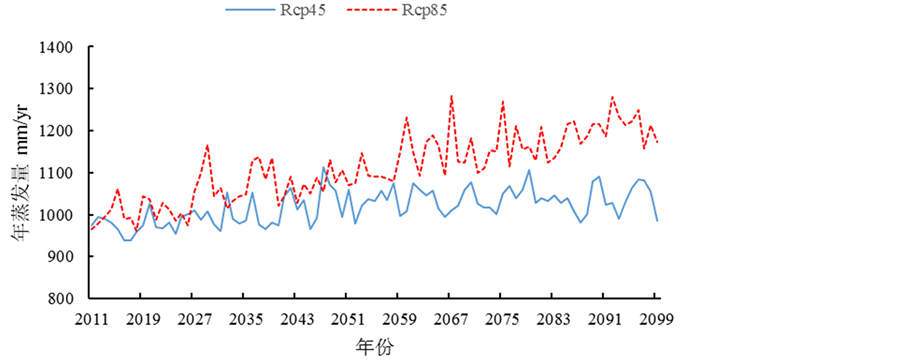1. 引言
气候变化及其水循环的影响,特别是对区域水文系统的影响是21世纪各国可持续发展中面临的重大课题[1] [2] 。蒸散发作为水循环中的重要组成部分,其变化影响着全球的水文循环。参照蒸发量是确定集水区水量损失的关键水文要素,用来计算实际蒸发蒸腾量,制定灌溉制度以及作为水文模型的输入数据[3] -[7] 。大气中CO2的增加会改变全球的能量平衡,导致全球气候变暖,伴随着气候变暖,全球水循环被改变,反过来又影响到生态、社会、经济等和人类相关的各个方面[8] [9] 。
本文基于实测气象数据和Penman-Monteith (P-M)方法计算长江流域近50年各站点的逐日参照蒸发量(ET0),分析了长江流域近50年来ET0的变化趋势及空间分布,分析评估SDSM模型对模拟长江流域参照蒸发量的适用性,重点分析日参照蒸发量的降尺度效果,揭示长江流域未来在不同气候情景下ET0的变化趋势,为开展气候变化对长江流域水资源的影响研究提供基础和支撑。
2. 数据和方法
2.1. 研究区域概况
长江流域位于24˚27~35˚54'N,90˚33~122˚19'E之间,流域面积180 × 104 km2,全国总面积的18.8%,流域地势变化幅度大,西高东低并呈现三大阶梯状,海拔从5000 m以上到500 m以下。长江流域的地貌类型复杂多样,高原、山地和丘陵盆地占绝大部分,平原面积较小。由于地域辽阔,地形复杂,季风气候十分典型,长江流域分带性明显。长江流域是我国人口稠密、经济高度发达的地区,在我国国民经济发展中具有举足轻重的作用和地位。
长江流域多年平均年降水量为1126.7 mm,属于我国降水丰沛的地区。受局地环流和地形的影响,年降水量的空间分布非常不均匀,自东南向西北呈减少趋势。中下游地区除汉江水系和干流区下游外,年降水量均多于1100 mm。长江流域多年平均陆面蒸发量为541 mm,其地区分布趋势是中下游大于上游,平原和盆地大于山区,南岸大于北岸。按水系,鄱阳湖、太湖、洞庭湖流域及中、下游干流区陆面蒸发量较大;乌江、嘉陵江、岷江和汉江上游陆面蒸发量较小;金沙江陆面蒸发量最小。从年陆面蒸发量等值线分布趋势看,以500 mm等值线贯穿地区最广,此线的西部和北部,多处在300~400 mm之间,在长江江源北部不足200 mm,为全流域最低值区;此线以东、以南,大多为600~700 mm,个别地区达800余mm;四川盆地、金沙江下游、乌江及长江中游部分地区,大都在500~600 mm之间;在洞庭湖区至江汉平原,达700~800 mm,并有一个800 mm的闭合圈;在鄱阳湖区,也有一个大于800 mm的高值区,其中赣江流域的吉安,陆面蒸发量超过1000 mm,是长江流域最大值;长江中下游干流区间陆面蒸发量也达700~800 mm。长江流域各地陆面蒸发有随高程增加而递减的趋势,即高程越高,陆面蒸发量越小;高程越低,陆面蒸发量越大。
2.2. 数据来源
本研究主要用到了三种数据类型,包括气象站的实测气象数据,NCEP (National Center for Environment Prediction)再分析数据和GCM输出数据。实测气象数据为长江流域134个气象站1961~2010年包括气温、风速、日照和相对湿度等逐日气象资料,流域内气象站点的分布情况如图1所示。NCEP数据中,选取了7个大气因子,包括海平面气压、海平面处温度、500 hPa处纬向风速、500 hPa的位势高度、850 hPa处比湿、850 hPa处相对湿度、850 hPa处温度。综合考虑GCM模式在中国地区的适应性、模式的分辨率和数据资料的连续性,GCM数据采用Postdam气候影响研究所的数据在Rcp45和Rcp85的情景下输出2011~2099年的ET0序列。
2.3. 参照蒸发量估算方法
在ET0的计算方面采用世界粮农组织(FAO)推荐的参照蒸发量的标准计算方法Penman-Monteith (P-M)公式,如下:
 (1)
(1)
式中,ET0为参照蒸发量,mm/d;为净辐射;G为土壤热通量,MJ/m2∙d;T为平均温度,℃;u2为2 m处的风速,m/s;为平均饱和水汽压,kPa;为实际水汽压,kPa;饱和水汽压曲线斜率,kPa/℃;为干湿常数,kPa/℃。
2.4. 趋势分析方法 [10] - [12]
本研究采用Mann-Kendall检验进行趋势分析。在时间序列趋势分析中,Mann-Kendall检验是世界气象组织推荐并已被广泛使用的非参数检验方法,最初由Mann和Kendall提出,现已被很多学者用来分析降雨、气温、

Figure 1. The location map of weather stations in Yangtze River basin
图1. 长江流域位置和气象站点分布
径流和水质等要素时间序列的趋势变化。Mann-Kendall检验不需要样本遵从一定的分布,也不受少数异常值的干扰,适用于水文、气象等非正态分布的数据,计算简便。
在Mann-Kendall检验中,原假设H0为时间序列数据( ),是n个独立的、随机变量同分布的样本;备择假设H1是双边检验,对于所有的
),是n个独立的、随机变量同分布的样本;备择假设H1是双边检验,对于所有的 ,且
,且 ,xk和xj的分布是不相同的,检验的统计变量S计算如下式:
,xk和xj的分布是不相同的,检验的统计变量S计算如下式:
 (2)
(2)
其中
 (3)
(3)
S为正态分布,其均值为0,方差Var(S)按下式计算:
 (4)
(4)
当n > 10时,标准的正态统计变量通过下式计算:
 (5)
(5)
这样,在双边的趋势检验中,在给定的 置信水平上,如果
置信水平上,如果 ,则原假设是不可接受的,即在
,则原假设是不可接受的,即在 置信水平上,时间序列数据存在明显的上升或下降趋势。而对于统计变量Z,若大于0,则时间序列呈上升趋势;若小于0,则时间序列是下降趋势。
置信水平上,时间序列数据存在明显的上升或下降趋势。而对于统计变量Z,若大于0,则时间序列呈上升趋势;若小于0,则时间序列是下降趋势。
2.5. 统计降尺度模型
本文对长江流域应用降尺度模型SDSM [13] -[15] ,选择ET0为预报量,遵循预报因子的选择原则,通过SDSM中的“筛选变量程序”进行相关分析,优选出与ET0相关性较高的5个大气因子,分别为海平面气压、海平面处温度、500 hPa处纬向风速、850 hPa处比湿、850 hPa处温度。基于1961~1990年长江流域各站点的ET0数据与所选择的NECP预报因子建立多元回归统计关系,计算SDSM天气发生器的模型参数,构建SDSM模型。同时利用1991~2010年的NCEP逐日数据对SDSM模型进行验证。将Rcp45与Rcp85输出到2011~2099年逐日数据出入到SDSM模型,模拟得到Rcp45和Rcp85情景下各站点ET序列。
为较系统地评价降尺度效果,本文采用效率系数,相关系数分别衡量模型对ET0的变化趋势的捕捉能力,利用平均偏差评价模型的系统偏差。
 (6)
(6)
 (7)
(7)
 (8)
(8)
3. 结果和讨论
3.1. 过去50年长江流域参照蒸发量的变化
根据P-M方程,计算长江流域1961~2010年逐日ET0,并由此计算长江流域历年参照蒸发量,如图2所示。长江流域的平均年ET0为957.8 mm,由图2可知,长江流域1961~2010年参照蒸发量年值呈混合的上下波动,1961~1981年有下降趋势,1991~2010年有上升的趋势。根据M-K检验结果Z = 2.54,1961~2010年间长江流域年ET0整体呈显著下降的趋势。
图3为长江流域1961~2010年各站点年ET0变化趋势的空间分布图。由图3中可以得到,1961~2010年间,有97个站点的年ET0序列呈下降趋势(占站点总数的72%),其中48个站点(占站点总数的36%)下降趋势显著(通过M-K检验95%置信水平,图中显著性通过实心三角形体现),集中在长江中下游区域、长江流域北部的区域;有38个站点的年ET0序列呈上升趋势,其中13个站点上升趋势显著。上升和下降趋势显著站点的平均标准正态统计量分别为2.71和−2.81。
3.2. 统计降尺度模型模拟效果评价
本研究对长江流域134个站点的模拟结果的平均值进行评价,并采用1961~1990年为率定期,1991~2010年为验证期。表1给出了SDSM模型在率定期与验证期对逐日ET0的模拟效果,其中率定期与检验期的相对误差Re均为9.25%,效率系数高达0.93,相关系数也都在0.93以上,证明SDSM模型在模拟长江流域的参照蒸散发效果较好。另外图4给出了检验期(1991~2010年) P-M法计算的月ET0和SDSM模型模拟的月ET0的结果比较。可以得出,基于NECP模拟的ET0及其变化规律与P-M法的计算值较为一致。总的来说,SDSM模型模拟的效果较好,可以用于GCM输出ET0结果的降尺度应用。
3.3. 未来气候变化情景下长江流域ET0的变化预测
经MK趋势分析可得,长江流域ET0在Rcp45情景下有显著的上升趋势,在Rcp85情景下亦有显著的上升趋势。由图5可知,在Rcp45及Rcp85的情景下,长江流域的年ET0均呈稳步上升的趋势,且变化趋势在Rcp85情景下较Rcp45情景下明显。长江流域的年ET0 Rcp85情景较Rcp45情景变化幅度大,上升趋势更加明显。

Figure 2. The temporal trend of annual ET0 in Yangtze River basin during 1961-2010
图2. 1961~2010年长江流域年ET0变化趋势

Figure 3. Spatial distribution of trends and their significance of ET0 during 1961-2010
图3. 1961~2010年ET0变化趋势及显著性的空间分布

Figure 4. Comparison of calculated and simulated monthly ET0 by SDSM driven by NECP scenarios in validation period
图4. 检验期基于SDSM的NECP情景下月ET0模拟值与历史计算值的比较

Figure 5. The annual mean ET0 simulations from Rcp45 and Rcp85 scenario in Yangtze River basin from 2011 to 2099
图5. Rcp45与Rcp85情景下2011-2099年长江流域年ET0的模拟
由表2可得,Rcp45的情景下,2011~2099年长江流域有131个站点(占站点总数的98%)呈上升趋势,其中显著上升的站点有115个(占站点总数的86%);Rcp85的情景下,2011~2099年长江流域有134个站点(占站点总数的100%)全部呈显著上升趋势。Rcp45与Rcp85情景下的显著上升站点的平均标准正态统计量分别为4.23

Table 1. Performance assessment for SDSM predictands during calibration and validation periods
表1. 统计降尺度模型率定期和验证期的模拟效果评价

Table 2. Trends of the annual mean ET0 simulations from Rcp45 and Rcp85 scenario in Yangtze River Basin from 2011 to 2099
表2. Rcp45和Rcp85条件下2011~2099年长江流域各站点年ET0变化趋势统计
和7.69综上所述,长江流域的ET在21世纪会持续上升。
4. 结论
基于历史气象资料和Rcp45及Rcp85d统计降尺度输出,结合FAO P-M公式和统计降尺度SDSM法,计算了过去50年和模拟未来89年Rcp45和Rcp85情景下长江流域ET0,使用Mann-Kendall方法对ET0进行趋势分析,得到以下认识:
1) 基于SDSM的ET0模拟值和PM公式计算值在率定期和检验期均比较一致,证实了SDSM模型对ET0的模拟效果较好,可以用来预测未来情景下的ET0。
2) 1961~2010年长江流域的平均ET0年值呈下降趋势,下降趋势显著的站点主要分布在长江中下游,流域的北部及东部。
3) 2011~2099年在Rcp45和Rcp85两种气候情景下,长江流域的ET0年值呈增加趋势,在Rcp85情景下增加趋势较Rcp45的情景下更加明显。
基金项目
国家自然科学基金(51339004; 51279138)。